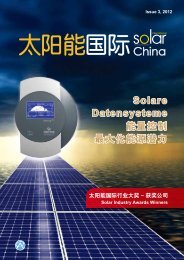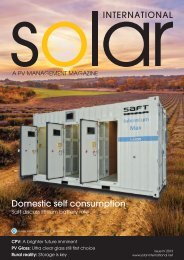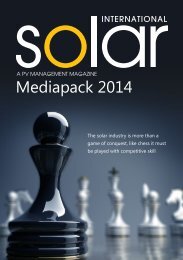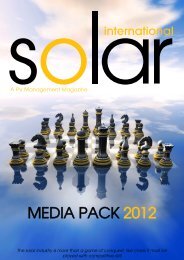A clearer road ahead
A clearer road ahead - Solar International Magazine
A clearer road ahead - Solar International Magazine
- No tags were found...
Create successful ePaper yourself
Turn your PDF publications into a flip-book with our unique Google optimized e-Paper software.
Module Manufacturing<br />
Innovation Award<br />
SJ3 Cell<br />
MANY multi-junction solar cell technologies are lattice<br />
mismatched and therefore have defects within the cell.<br />
Additional material is used to try and buffer the defects which<br />
results in stunted efficiency gains and reliability issues.<br />
Solar Junction's technology is lattice matched resulting in higher<br />
performance yield reliability and lower cost.<br />
Solar Junction has successfully produced III-V multi-junction<br />
solar cells using dilute nitrides reaching high-efficiencies. The<br />
material substrates used by the company allows for a tunable<br />
and lattice-matched structure that has not been obtained by<br />
others.<br />
Solar Junction's cells incorporate the<br />
company's proprietary adjustable<br />
spectrum lattice-matched A-SLAM<br />
technology which enables the<br />
company to more optimally partition<br />
the solar spectrum. This enables<br />
bandgap tunability over the solar<br />
spectrum to maximize the absorbed<br />
sunlight within the CPV modules while<br />
enabling lattice-matched pathway to<br />
solar cell efficiencies beyond 50% within<br />
the decade. This technology leads to<br />
maximum efficiency and greater reliability. It is a<br />
sustainable technology that leads to a <strong>road</strong>map of<br />
continual efficiency gains and innovation without changing the<br />
fundamental structure of the cell which is not true for other multijunction<br />
solar cell providers.<br />
Solar Junction breaks with multi-junction innovations by<br />
continuing on a lattice-matched path leading to higher<br />
efficiencies and higher reliability. The cell structure maintains<br />
pure while other companies are using innovations that use<br />
different processes that do not maintain a lattice-matched<br />
structure. Solar Junction standard cell achieved 40.9% efficiency<br />
in January 2011 which was tested and verified by the National<br />
Energy Laboratory (NREL.)<br />
The cells submitted where standard design production cells and<br />
manufactured entirely in-house on its production line in<br />
San Jose. CA. February 2011 Solar Junction<br />
reached a 41.4% efficiency on a production<br />
cell again validated by NREL. The cell<br />
submitted for testing was also a standard<br />
commercial-ready production cell. It is<br />
significant because it was not a champion<br />
cell gain but a product that could be<br />
introduced straight into a customer's line.<br />
In April 2011 Solar Junction broke the<br />
World Record in cell efficiency. At 43.5%<br />
efficiency Solar Junction has retained the<br />
world record for the past year and continues<br />
to strive to make additional technology<br />
improvements to reach higher efficiency percentages.<br />
The cell tested by NREL was once again a standard<br />
5.5mm x 5.5mm production cell.<br />
44 www.solar-international.net I Issue IX 2012








